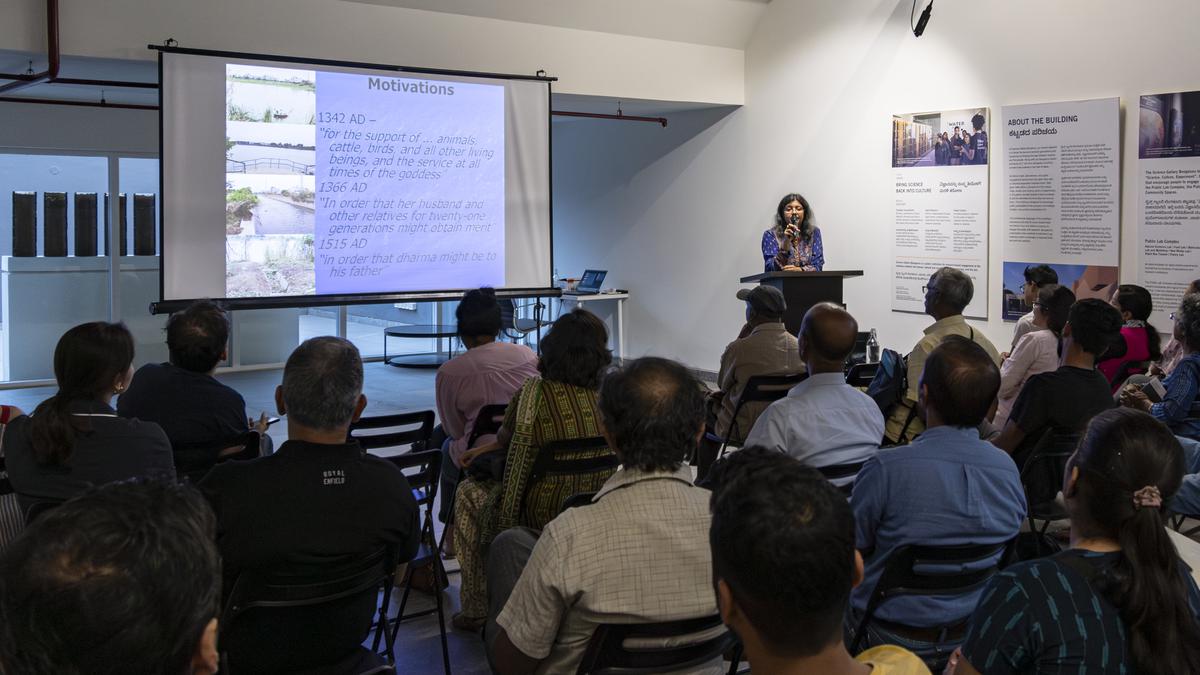
How Bengaluru grew and thrived around lakes Premium
The Hindu
Harini Nagendra brings up the founding myth about modern Bengaluru: how the great warrior Kempe Gowda, a chieftain under the Vijayanagara Empire, saw a hare chasing a hunting dog, a sign of immense bravery. He referred to this area as Gandubhoomi, the land of heroes, and decided that it would be auspicious to build a city here, starting with a fort. “But how did he create a market town in Bangalore? There must have (already) been some activity,“ says Harini, going into the prehistoric past of Bengaluru at a recent lecture titled Bangalore Lakes: An Ecological History at the Science Gallery Bengaluru.
Harini Nagendra brings up the founding myth about modern Bengaluru: how the great warrior Kempe Gowda, a chieftain under the Vijayanagara Empire, saw a hare chasing a hunting dog, a sign of immense bravery. He referred to this area as Gandubhoomi, the land of heroes, and decided that it would be auspicious to build a city here, starting with a fort. “But how did he create a market town in Bangalore? There must have (already) been some activity,“ says Harini, going into the prehistoric past of Bengaluru at a recent lecture titled Bangalore Lakes: An Ecological History at the Science Gallery Bengaluru.
The area, which would become Bengaluru, she says, was a very old settlement, as the discovery of megalithic stone tools from 3500 years ago indicates. While other discoveries, like ancient jars filled with coins from all over the world, estimated to be around 2000-odd years old, suggest that Bengaluru must have been an important centre for trade, commerce and cultural exchange, how civilisation developed here is still somewhat mysterious. “
“In your school geography textbooks, you always hear that you develop cities near water... that civilisations come from water,“ says the Bengaluru-based ecologist at the talk, which was part of the ongoing Critical Zones exhibition, a collaboration between Science Gallery Bengaluru and Goethe-Institut / Max Mueller Bhavan, Bangalore. “That makes Bengaluru very interesting because it has no perennial water supply. It is in the rain shadow of the Western Ghats,” she says, adding that in the absence of written record, we will never really know where ancient people got their water from.
Stone inscriptions dating as far back as the 5th and 6th centuries, however, give us some clues about the development of water systems in this area in the early common era. Using a series of maps, Nagendra explains how various lakes began emerging in the area which would become Bengaluru, beginning by going into the topography of the area, the hilly western part and the flatter eastern part. “The (old) High Ground Police Station used to be its highest point,” she says.
Drawing from various inscription stones, she also talks about the various dynasties that rose, ruled and fell over the centuries-- the Ganga Dynasty (6-9 centuries CE), the Cholas (10-12 centuries CE), the Hoysala Dynasty (13-14 centuries CE) and the Vijayanagara Dynasty (14-16 centuries CE)--and how their presence contributed to developing the water systems of Bengaluru. Kempe Gowda, she adds, had so pleased Achuta Deva Raya, the brother of Krishna Deva Raya, who also went on to rule Vijayanagara, that he was given a number of villages to support the market town that he had founded. “There was a vibrant economy because of all those things,” believes Harini, Director, Research Center & Centre for Climate Change, Azim Premji University..
She also mentions how the city’s lakes were created not only by rulers but also by common people (one even by a prostitute) and goes into the connection between water and worship. “They went to a landscape and looked at where the low-lying muddy patches were. From this, they scooped out mud and made the lakes,” she says, describing how cultures were constructed, how history played out, and even how warfare was carried out because of the city’s water bodies. “Lakes were part of the imagination and a way of life,” she believes.
Changing city













